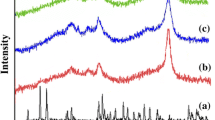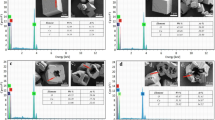Abstract
The effects of sodium gluconate (HOCH2(CHOH)4COONa; abbreviated as SG) on the morphology of hydrohematite particles produced from a forced hydrolysis reaction were investigated. It is evident from transmission electron microscopy (TEM) and field-emission scanning electron microscopy (FE-SEM) measurements that a fraction of the particles produced in these reactions lost their spherical habit and acquired a columnar shape upon the addition of small amounts of SG. FE-SEM images of the particles reveal that the columnar hydrohematite particles possessed top-face diameters that were the same as their edge lengths (heights). Because of their similar lengths, the columnar particles were imaged as both spheres and squares by TEM observation. The unit cell dimensions of the a-axis of the hydrohematite particles were almost constant at 0.5040 ± 0.0004 nm. The c-axis, however, was slightly larger than was reported in previous studies and became further enlarged upon increase of the SG concentration above 0.3 mol%, at which point the columnar particles were precipitated. This was explained by considering the replacement of O2− ions with OH− to compensate for the charge imbalance resulting from Fe3+ vacancies on the basis of the general chemical formula of α-Fe2−x/3(OH)xO3−x. The presence of OH− ions in the hydrohematite particles was identified by in situ Fourier transform infrared (FTIR) spectroscopy and thermogravimetric differential thermal analysis (TG-DTA) measurements. Since the specific surface area of the hydrohematite particles were observed to increase with increasing SG concentration, it was presumed that the hydrohematite particles were produced by the aggregation of clustered particles. Time-resolved TEM observations over a period of 12–18 h after initiation of the reaction for the system with 0.3 mol% SG revealed that columnar particles are produced by the deposition of clustered particles with ca. 10 nm in diameter onto the spherical particles. The edges of columnar particles then become right-angled following this deposition. It can be concluded that the SG molecules behaved as a morphology control agent because no SG molecule remained in the columnar particles.










Similar content being viewed by others
References
Peng ZA, Peng X (2002) Nearly monodisperse and shape-controlled CdSe nanocrystals via alternative routes: nucleation and growth. J Am Chem Soc 124:3343–3353
Wang X, Zhuang J, Peng Q, Li Y (2005) A general strategy for nanocrystal synthesis. Nature 437:121–124
Yin Y, Alivisatos AP (2005) Colloidal nanocrystal synthesis and the organic–inorganic interface. Nature 437:664–670
Schwertmann U, Cornell RM (1996) Iron oxide, structure, properties, reactions, occurrence and uses. VCH
Sun Y, Xia Y (2002) Shape-controlled synthesis of gold and silver nanoparticles. Science 298:2176–2179
Lin Y, Abel PR, Heller A. Mullins CB (2011) α-Fe2O3 nanorods as anode materials for lithium ion batteries. J Phys Chem Lett 2:2885–2891
Zhong LS, Hu JS, Liang HP, Cao AM, Song WG, Wan LJ (2006) Self-assembled 3D flowerlike iron oxide nanostructures and their application in water treatment. Adv Mater 18:2426–2431
Zeng SY, Tang KB, Li TW, Liang ZH, Wang D, Wang YK, Zhou WW (2007) Hematite hollow spindles and microspheres: selective synthesis, growth mechanisms, and application in lithium ion battery and water treatment. J Phys Chem C 111:10217–10225
Piao Y, Kim J, Na HB, Kim D, Baek JS, Ko MK, Lee JH, Shokouhimehr M, Hyeon T (2008) Wrap–bake–peel process for nanostructural transformation from β-FeOOH nanorods to biocompatible iron oxide nanocapsules. Nat Mater 7:242–247
Wen X, Wang S, Ding Y, Wang ZL, Yang S (2005) Controlled growth of large-area, uniform, vertically aligned arrays of α-fe2o3nanobelts and nanowires. J Phys Chem B 109:215–220
Jia CJ, Sun LD, Yan ZG, You LP, Luo F, Han XD, Pang YC, Zhang Z, Yan CH (2005) Single-Crystalline Iron Oxide Nanotubes. Angew Chem Int Ed 44:4328–4333
Liu LH, Kou HZ, Mo W, Liu H, Wang Y (2006) Surfactant-assisted synthesis of α-Fe2O3 nanotubes and nanorods with shape-dependent magnetic properties. J Phys Chem B 110:15218–15223
Wang SB, Min YL, Yu SY (2007). J Phys Chem C 111:3351–3354
Liang X, Wang X, Zhuang J, Chen Y, Wang D, Li Y (2006) Synthesis of nearly monodisperse iron oxide and oxyhydroxide nanocrystals. Adv Funct Mater 16:1805–1813
Kandori K, Kawashima Y, Ishikawa T (1991) Characterization of monodispersed haematite particles by gas adsorption and Fourier-transform infrared spectroscopy. J Chem Soc Faraday Trans 87:2241–2246
Kandori K, Tamura S, Ishikawa T (1994) Inner structure and properties of diamond-shaped and spherical ?-Fe2O3 particles. Colloid Polym Sci 272:812–819
Kandori K, Okoshi N, Yasukawa A, Ishikawa T (1998) Morphology control and texture of hematite particles by dimethylformamide in forced hydrolysis reaction. J Mater Res 13:1698–1706
Kandori K, Okamoto N, Ishikawa T (2002) Preparation of nanoporous micrometer-scale hematite particles by a forced hydrolysis reaction in the presence of polyethylene glycol. Langmuir 18:2895–2900
Kandori K, Ishikawa T (2001) TPD–MS–TG study of hematite particles produced by the forced hydrolysis reaction. Phys Chem Chem Phys 3:2949–5954
Kandori K, Watanabe M (2010). Colloid Polym Sci 289:981
Kandori K (2006) Iron oxide particles. In: Hubbert A (ed) Encyclopedia of surface and colloid science2nd edn. Taylor & Francis, New York, pp 3126–3138
Wolska E, Schwertmann U (1989) Nonstoichiometric structures during dihydroxylation of goethite. Z. Kristallogr 189:223–237
Cölfen H, Mann S (2003) Higher-order organization by mesoscale self-assembly and transformation of hybrid nanostructures. Angw Chem Int Ed 42:2350–2365
Cölfen H, Antonietti M (2005) Mesocrystals: inorganic superstructures made by highly parallel crystallization and controlled alignment. Angw Chem Int Ed 44:5576–5591
Ahmed S, Ryan KM (2007) Self-assembly of vertically aligned nanorod supercrystals using highly oriented pyrolytic graphite. Nano Lett 7:2480–2485
Inumura K (2006) “Sponge Crystal”: a novel class of microporous single crystals formed by self-assembly of polyoxometalate (NH4)3PW12O40 nanocrystallites. Catal Surv Asia 10:151–160
Li HY, Estroff LA (2007) Porous calcite single crystals grown from a hydrogel medium. CrystEngComm 9:1153–1155
Matijević E, Sceiner P (1978) Ferric hydrous oxide sols. J Colloid Interface Sci 63:509–524
Hsu WP, Ronnquist L, Matijević E (1988) Preparation and properties of monodispersed colloidal particles of lanthanide compounds. 2. Cerium(IV). Langmuir 4:31–37
Jonga N, Browen P, Lemaitre J, Valmalette JC, Hofmamm H (2000). J Colloid Interface Sci 226:189–198
Lee SH, Her YS, Matijević E (1997) Preparation and growth mechanism of uniform colloidal copper oxide by the controlled double-jet precipitation. J Colloid Interface Sci 186:193–202
Kandori K, Yonekawa G (2013). Colloid Polym Sci 29:1855–1890
Tasaki K, Okawa Y, Shiba F (2015) Proceeding of the 66th Divisional Meeting of Colloid and Surface Chemistry, The Chemical Society of Japan, p 40
Kandori K, Yonekawa G (2014) Preparation and characterization of uniform pseudocubic hematite particles by utilizing polyethylene oxide polymers in forced hydrolysis reaction. J Ceram Soc Jpn 122:795–801
Acknowledgments
Thanks are due to Dr. Ichihito Narita in Osaka University of Education for the FE-SEM measurements.
Author information
Authors and Affiliations
Corresponding author
Ethics declarations
Conflict of interest
The authors declare that they have no conflict of interest.
Rights and permissions
About this article
Cite this article
Kandori, K., Nakazono, O. Preparation and characterization of columnar hydrohematite particles from a forced hydrolysis reaction using sodium gluconate. Colloid Polym Sci 296, 1795–1803 (2018). https://doi.org/10.1007/s00396-018-4404-x
Received:
Revised:
Accepted:
Published:
Issue Date:
DOI: https://doi.org/10.1007/s00396-018-4404-x




